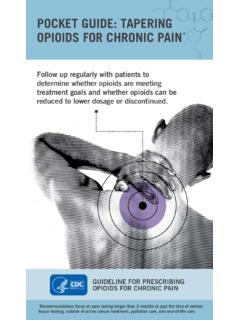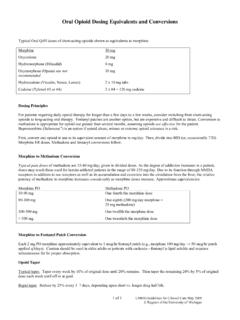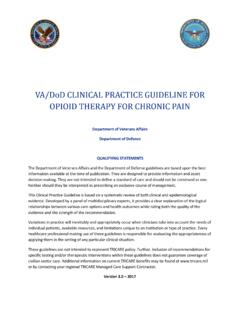Transcription of Guideline for Prescribing Opioids for Chronic Pain
1 123 LEARN MORE | FOR Prescribing Opioids FOR Chronic PAINCDC s Guideline for Prescribing Opioids for Chronic Pain is intended to improve communication between providers and patients about the risks and benefits of opioid therapy for Chronic pain, improve the safety and effectiveness of pain treatment, and reduce the risks associated with long-term opioid therapy, including opioid use disorder and overdose. The Guideline is not intended for patients who are in active cancer treatment, palliative care, or end-of-life PRACTICE THROUGH RECOMMENDATIONSDETERMINING WHEN TO INITIATE OR CONTINUE Opioids FOR Chronic PAINN onpharmacologic therapy and nonopioid pharmacologic therapy are preferred for Chronic pain.
2 Clinicians should consider opioid therapy only if expected benefits for both pain and function are anticipated to outweigh risks to the patient. If Opioids are used, they should be combined with nonpharmacologic therapy and nonopioid pharmacologic therapy, as starting opioid therapy for Chronic pain, clinicians should establish treatment goals with all patients, including realistic goals for pain and function, and should consider how opioid therapy will be discontinued if benefits do not outweigh risks. Clinicians should continue opioid therapy only if there is clinically meaningful improvement in pain and function that outweighs risks to patient safety.
3 Before starting and periodically during opioid therapy, clinicians should discuss with patients known risks and realistic benefits of opioid therapy and patient and clinician responsibilities for managing REMINDERS Opioids are not first-line or routine therapy for Chronic pain Establish and measure goals for pain and function Discuss benefits and risks and availability of nonopioid therapies with patientOPIOID SELECTION, DOSAGE, DURATION, FOLLOW-UP, AND DISCONTINUATION456891011127 CLINICAL REMINDERS Use immediate-release Opioids when starting Start low and go slow When Opioids are needed for acute pain, prescribe no more than needed Do not prescribe ER/LA Opioids for acute pain Follow-up and re-evaluate risk of harm; reduce dose or taper and discontinue if needed When starting opioid therapy for Chronic pain, clinicians should prescribe immediate-release Opioids instead of extended-release/long-acting (ER/LA) Opioids are started, clinicians should prescribe the lowest effective dosage.
4 Clinicians should use caution when Prescribing Opioids at any dosage, should carefully reassess evidence of individual benefits and risks when considering increasing dosage to 50 morphine milligram equivalents (MME)/day, and should avoid increasing dosage to 90 MME/day or carefully justify a decision to titrate dosage to 90 opioid use often begins with treatment of acute pain. When Opioids are used for acute pain, clinicians should prescribe the lowest effective dose of immediate-release Opioids and should prescribe no greater quantity than needed for the expected duration of pain severe enough to require Opioids .
5 Three days or less will often be sufficient; more than seven days will rarely be should evaluate benefits and harms with patients within 1 to 4 weeks of starting opioid therapy for Chronic pain or of dose escalation. Clinicians should evaluate benefits and harms of continued therapy with patients every 3 months or more frequently. If benefits do not outweigh harms of continued opioid therapy, clinicians should optimize other therapies and work with patients to taper Opioids to lower dosages or to taper and discontinue RISK AND ADDRESSING HARMS OF opioid USEB efore starting and periodically during continuation of opioid therapy, clinicians should evaluate risk factors for opioid -related harms.
6 Clinicians should incorporate into the management plan strategies to mitigate risk, including considering offering naloxone when factors that increase risk for opioid overdose, such as history of overdose, history of substance use disorder, higher opioid dosages ( 50 MME/day), or concurrent benzodiazepine use, are present. Clinicians should review the patient s history of controlled substance prescriptions using state prescription drug monitoring program (PDMP) data to determine whether the patient is receiving opioid dosages or dangerous combinations that put him or her at high risk for overdose.
7 Clinicians should review PDMP data when starting opioid therapy for Chronic pain and periodically during opioid therapy for Chronic pain, ranging from every prescription to every 3 Prescribing Opioids for Chronic pain, clinicians should use urine drug testing before starting opioid therapy and consider urine drug testing at least annually to assess for prescribed medications as well as other controlled prescription drugs and illicit should avoid Prescribing opioid pain medication and benzodiazepines concurrently whenever should offer or arrange evidence-based treatment (usually medication-assisted treatment with buprenorphine or methadone in combination with behavioral therapies)
8 For patients with opioid use REMINDERS Evaluate risk factors for opioid -related harms Check PDMP for high dosages and prescriptions from other providers Use urine drug testing to identify prescribed substances and undisclosed use Avoid concurrent benzodiazepine and opioid Prescribing Arrange treatment for opioid use disorder if neededLEARN MORE |

















